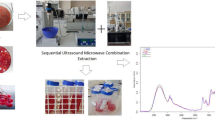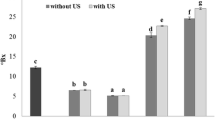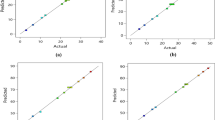Abstract
The extraction of soluble matter (°Brix), catechin and total phenolic compounds (TPC) from apple flesh was studied. A conventional aqueous extraction (CE) was done at different temperatures (50, 60, and 75 °C). A pulsed ultrasound-assisted extraction (UAE) was done at fixed temperature, T = 50 °C, and different specific energy input and total duration. The main attention was focused on correlations between oBrix, concentration of catechin, C, TPC, and selectivity of phenolics extraction. For UAE, the significant acceleration in extraction of catechin was observed for the short duration protocol as compared with long duration one. The maximum (saturation) levels for concentrations of catechin, Cm, and total phenolic compounds, TPCm, were compared. In correlation between Cm and TPCm, the two distinctive branches were observed for CE protocols and UAE protocols. Moreover, the relative contents of catechin in TPC were noticeably higher for UAE protocols as compared with CE protocols.








Similar content being viewed by others
References
Watson RR (2014) Polyphenols in plants. Isolation, purification and extract preparation. Academic Press, Cambridge
Joseph SV, Edirisinghe I, Burton-Freeman BM (2016) Fruit polyphenols: a review of anti-inflammatory effects in humans. Crit Rev Food Sci Nutr 56:419–444
Becker EM, Nissen LR, Skibsted LH (2004) Antioxidant evaluation protocols: food quality or health effects. Eur Food Res Technol 219:561–571
Coman MM, Oancea AM, Verdenelli MC et al (2018) Polyphenol content and in vitro evaluation of antioxidant, antimicrobial and prebiotic properties of red fruit extracts. Eur Food Res Technol 224:735–745
Weichselbaum E, Wyness L, Stanner S (2010) Apple polyphenols and cardiovascular disease–a review of the evidence. Nutr Bull 35:92–101
Jiang H, Ji B, Liang J et al (2006) Changes of contents and antioxidant activities of polyphenols during fruit development of four apple cultivars. Eur Food Res Technol 223:743
Podsędek A, Wilska-Jeszka J, Anders B, Markowski J (2000) Compositional characterisation of some apple varieties. Eur Food Res Technol 210:268–272
Oszmiański J, Lachowicz S, Gławdel E et al (2017) Determination of phytochemical composition and antioxidant capacity of 22 old apple cultivars grown in Poland. Eur Food Res Technol 244:647–662
Heimler D, Romani A, Ieri F (2017) Plant polyphenol content, soil fertilization and agricultural management: a review. Eur Food Res Technol 243:1107–1115
Caballero-Valdés E, Olivares-Miralles A, Soto-Maldonado C, Zúñiga-Hansen ME (2016) Advances in technologies for producing food-relevant polyphenols. In: Cuevas Valenzuela J, Pérez-Correa JRV-SJR (ed) Advances in technologies for producing food-relevant polyphenols. CRC Press, Boca Raton, pp 63–78
Vaher M, Koel M (2003) Separation of polyphenolic compounds extracted from plant matrices using capillary electrophoresis. J Chromatogr A 990:225–230
Pingret D, Fabiano-Tixier A-S, Le Bourvellec C et al (2012) Lab and pilot-scale ultrasound-assisted water extraction of polyphenols from apple pomace. J Food Eng 111:73–81
Severini C, Derossi A, Fiore AG (2017) Ultrasound-assisted extraction to improve the recovery of phenols and antioxidants from spent espresso coffee ground: a study by response surface methodology and desirability approach. Eur Food Res Technol 243:835–847
Barba FJ, Parniakov O, Pereira SA et al (2015) Current applications and new opportunities for the use of pulsed electric fields in food science and industry. Food Res Int 77:773–798
Donsì F, Ferrari G, Pataro G (2010) Applications of pulsed electric field treatments for the enhancement of mass transfer from vegetable tissue. Food Eng Rev 2:109–130
Jacotet-Navarro M, Rombaut N, Deslis S et al (2016) Towards a “dry” bio-refinery without solvents or added water using microwaves and ultrasound for total valorization of fruit and vegetable by-products. Green Chem 18:3106–3115
Chemat F, Rombaut N, Sicaire A-G et al (2017) Ultrasound assisted extraction of food and natural products. Mechanisms, techniques, combinations, protocols and applications. A review. Ultrason Sonochem 34:540–560
Chemat F, Rombaut N, Meullemiestre A et al (2017) Review of green food processing techniques. Preservation, transformation, and extraction. Innov Food Sci Emerg Technol 41:357–377
Khadhraoui B, Turk M, Fabiano-Tixier AS et al (2018) Histo-cytochemistry and scanning electron microscopy for studying spatial and temporal extraction of metabolites induced by ultrasound. Towards chain detexturation mechanism. Ultrason Sonochem 42:482–492
Chemat F, Vian MA, Cravotto G (2012) Green extraction of natural products: concept and principles. Int J Mol Sci 13:8615–8627
Pingret D, Fabiano-Tixier A-S, Chemat F (2013) Degradation during application of ultrasound in food processing: a review. Food Control 31:593–606
Arts ICW, Van de Putte B, Hollman PCH (2000) Catechin contents of foods commonly consumed in The Netherlands. 2. Tea, wine, fruit juices, and chocolate milk. J Agric Food Chem 48:1752–1757
Włodarska K, Pawlak-Lemanska K, Khmelinskii I, Sikorska E (2016) Explorative study of apple juice fluorescence in relation to antioxidant properties. Food Chem 210:593–599
Singleton VL, Orthofer R, Lamuela-Raventós RM (1999) Analysis of total phenols and other oxidation substrates and antioxidants by means of folin-ciocalteu reagent. Methods Enzymol 299:152–178
Parniakov O, Barba FJ, Grimi N et al (2016) Extraction assisted by pulsed electric energy as a potential tool for green and sustainable recovery of nutritionally valuable compounds from mango peels. Food Chem 192:842–848
Parniakov O, Barba FJ, Grimi N et al (2014) Impact of pulsed electric fields and high voltage electrical discharges on extraction of high-added value compounds from papaya peels. Food Res Int 65:337–343
Barba FJ, Parniakov O, Koubaa M, Lebovka N (2016) Handbook of electroporation. In: Miklavcic D (ed) Springer, New York, pp 1–18
Gradshteyn IS, Ryzhik IM, Jeffrey A, Zwillinger D (1980) Tables of integrals, series and products. Academic Press, Cambridge
Acknowledgements
The authors would like to thank Dr Grimi, N. for his technical assistance. This work was supported by the China Scholarship Council and by Université de Technologie de Compiègne, France.
Author information
Authors and Affiliations
Corresponding author
Ethics declarations
Conflict of interest
The authors declare that they have no conflict of interest.
Human and animal rights statement
This article does not contain any studies with human or animal subjects.
Rights and permissions
About this article
Cite this article
Wang, L., Boussetta, N., Lebovka, N. et al. Comparison of conventional and ultrasound-assisted aqueous extraction of soluble matter and phenolic compounds from apple flesh. Eur Food Res Technol 244, 1683–1689 (2018). https://doi.org/10.1007/s00217-018-3081-9
Received:
Revised:
Accepted:
Published:
Issue Date:
DOI: https://doi.org/10.1007/s00217-018-3081-9




